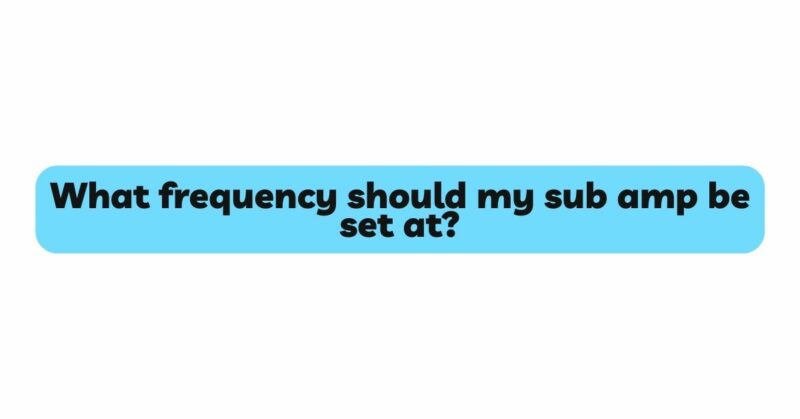Subwoofers serve as the backbone of any audio setup, elevating the listening experience by delivering powerful and immersive low-frequency sounds. Optimizing your subwoofer amplifier’s frequency settings is crucial to achieving the perfect balance between precision and impact in bass reproduction. In this comprehensive guide, we delve into the intricacies of subwoofer amplifier frequency settings, exploring the concepts of crossover frequency, low-pass filters, and phase alignment, to help you unlock the full potential of your subwoofer’s bass performance.
- Decoding Crossover Frequency
The crossover frequency is the point at which the subwoofer takes over from the main speakers in reproducing sound. It’s a critical parameter that ensures a smooth transition between the main speakers and the subwoofer, preventing sonic gaps or overlaps. Finding the right crossover frequency requires consideration of both your subwoofer’s capabilities and your main speakers’ frequency response.
Typically, crossover frequencies for subwoofers fall within the range of 80 to 120 Hz. However, the ideal value depends on various factors, including the size of your main speakers, the acoustics of your room, and personal preferences. Smaller speakers may require a higher crossover frequency, while larger speakers can be crossed over lower.
- Matching Crossover Frequency with Speaker Size
One guideline for selecting crossover frequency is to match it with the lower limit of your main speakers’ frequency response. For instance, if your main speakers can comfortably reproduce frequencies down to 60 Hz, setting the crossover frequency for your subwoofer around 60-70 Hz could ensure a cohesive transition.
However, keep in mind that the ideal crossover frequency also depends on the type of content you’ll be listening to. For music with prominent bass lines, a higher crossover frequency might work well, while for movie soundtracks with deeper bass, a lower frequency might be preferred.
- Low-Pass Filters: Enhancing Precision
Low-pass filters are essential tools for subwoofer amplifiers, as they determine the upper limit of frequencies that the subwoofer will reproduce. These filters prevent the subwoofer from attempting to reproduce frequencies that are better handled by the main speakers.
Setting the low-pass filter just above your chosen crossover frequency helps ensure a seamless overlap between the main speakers and the subwoofer. This approach prevents any gaps in the frequency spectrum and enhances the precision of bass reproduction.
- Phase Alignment: Achieving Sonic Coherence
Phase alignment ensures that the sound waves produced by the subwoofer and the main speakers are in sync. When these waves are out of phase, they can interfere with each other, causing cancellations and uneven sound distribution.
Many subwoofers have a phase control that allows you to adjust the phase in increments of 0 or 180 degrees. Experiment with this setting while playing audio with strong bass content. Select the phase setting that results in the fullest and most coherent bass response.
- Room Acoustics and Subwoofer Placement
It’s important to consider the acoustic characteristics of your listening room when setting subwoofer frequencies. Bass frequencies can interact with room boundaries, leading to resonances and uneven bass distribution. Experiment with subwoofer placement to minimize these room-induced distortions.
Placing your subwoofer near room boundaries, such as walls or corners, can often enhance bass output due to boundary reinforcement. However, be cautious of excessive bass buildup, which can lead to boomy or muddy sound. Adjust the crossover frequency and phase alignment based on the characteristics of your room to achieve a balanced bass response.
- Listening Tests and Iterative Adjustments
The key to achieving the perfect subwoofer frequency settings lies in iterative adjustments and attentive listening tests. Play a variety of music and content that feature different bass frequencies. Evaluate the cohesiveness of the bass response, the impact of bass notes, and the integration with the main speakers.
Gradually adjust the crossover frequency, low-pass filter, and phase settings while paying close attention to the changes in sound. Fine-tuning these settings over time will lead to a subwoofer performance that’s optimized for your specific audio setup and preferences.
Conclusion
Configuring subwoofer amplifier frequency settings is a process that involves understanding the interplay between your subwoofer, main speakers, room acoustics, and personal preferences. The right crossover frequency, low-pass filter, and phase alignment ensure a seamless blend between the main speakers and the subwoofer, resulting in a balanced and impactful bass response.
As you experiment with different settings, remember that your ears are your most valuable tools. Regularly conduct listening tests with a diverse range of audio content to assess the effectiveness of your adjustments. Be patient and willing to fine-tune your subwoofer amplifier frequency settings over time, as this iterative approach will ultimately lead you to a sonic experience characterized by depth, precision, and immersive bass reproduction.

